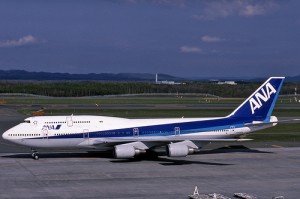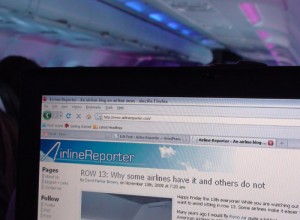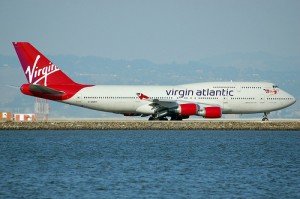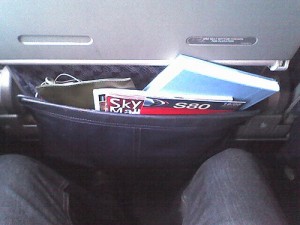
All Nippon Airways Boeing 747 (JA8955) waiting to take off.
Starting on March 1st, All Nippon Airways (ANA) will have women-only lavatories on their international planes (except the Boeing 737 or Airbus A320). These lavatories will be restricted to only female passengers and will have a pink logo on the doors.
Only under certain circumstances will male passengers be able to use the lavatories:
* When required for safety reasons, just prior to the seat belt sign being turned on during take-off and landing
* When a passenger is not feeling well and a personal emergency requires such use
* When there are very few female passengers and the women-only designation has been lifted for the flight. If this is the case, an in-flight announcement will be made.
I don’t want to go into too many details on why this might be a good idea, but a man using the restroom and turbulence could cause issues. Also women wouldn’t have to worry about putting down the seat.
Of course previously ANA has advised passengers to use the restroom before even boarding the plane to save on fuel and carbon emissions.
connect | web | twitter | facebook |
Image from 64N21W

I only read the best stuff while on my flights. Taken just a few minutes ago.
I am currently posting this from 36,239 feet on a Virgin America flight from San Francisco (SFO) to Seattle (SEA). The in-seat map tells me we are over Central Oregon. Today I flew to San Fran and I’m now flying right back to Seattle to test out Virgin America’s in-flight entertainment system. I will post a full review of my experience on Monday, but while enjoying the Wi-Fi, I wanted to talk about it a little bit.
I am currently accessing the internet via GoGo and I don’t have to pay a dime. Virgin America, with Google, is offering free Wi-Fi on all their flights from now until January 15, 2010. Delta Air Lines, with eBay, is providing free Wi-Fi for a week starting November 24th.
The free internet is not only for folks on an airplane. Until January 15, 2010 Google will provide complimentary Wi-Fi in 47 airports across the country, including Las Vegas, Boston, Houston, Miami, and Seattle.
Seattle was supposed to be one of the 47 airports with free Wi-Fi. However, when I was there earlier today, I was excited to do some blogging while waiting for my flight to leave but it wasn’t free. Luckily I have an iPhone (airline and tech nerd) and found that there is a contract issue between AT&T (the current provider) and the airport.
Other airports got the Wi-Fi this Tuesday, but Seattle won’t be seeing it until November 18th. Every cloud has its silver lining; Seattle and Burbank airports will have free Wi-fi forever. I guess I will be ok with no Wi-Fi today for perpetually free Wi-Fi in a few days.
I am no stranger to technology and I fly quite a bit, but every time I have the access to the internet while flying, it feels magical. Some people say the magic of flying is gone but I disagree, it just depends on who you fly.
Internet is the future of airline travel. I feel that all airlines will have internet access in the near future. Once an airline cuts the Wi-Fi for landing, it is only a few minutes to re-connect on the 3G network and be connected once again. Awhile back, I talked about the possibility of having free Wi-Fi on airlines, but Andrew Compart with Things with Wings came up with another possible change that Wi-Fi could cause.
He caught something interesting in the Google media release about the free Wi-Fi, “A recent study conducted by the Wi-Fi Alliance reported that 50% of business travelers take red-eye flights in order to be “reachable” during business hours, and an overwhelming 82% said that being connected through Wi-Fi would help solve that problem.”
He brings up a good question that with business travelers having access to Wi-Fi during their flights, will fewer take red eye flights? Will that affect an airline’s business flying at night? I hope not. For personal travel, I enjoy red-eyes since I am able to sleep and I want as much vacation time as possible.
A year ago, there was barely any Wi-Fi on any flights. Hopefully a year from now Wi-Fi will be so common that there’s nothing left to even write about.. I think I am going to wrap up now, time to play Doom for the rest of the flight back home!
follow via | web | twitter | email | rss |

Virgin Atlantic "Tubular Belle" Boeing 747-400 that is taxiing (get it?)
Have you ever flown into a large city, had to grab a taxi downtown and thought, “man there have to be other people doing the same thing? I wish I could save a few bucks and share a cab.” Maybe you had the guts to ask people around you where they were going, but for those of us who don’t, you now have another option.
Virgin Atlantic working with NESTA (UK endowment to support innovation) is helping to test a program to help passengers share a Taxi. Called Taxi2, passengers can sign up on their website, input their flight details, they are then sent information on a probable match and can choose to accept or reject the match. The site will let you pick the sex of your passenger (presumably for safety female passengers, not to set up a date) and the program is not limited to just Virgin Atlantic customers.
Ed Maklouf, founder of Taxi2, said, “We are delighted to be partnering with Virgin Atlantic for this scheme, and our expectation is that this simple, sensible way of saving money and cutting down congestion and carbon footprint will become common activity for air travelers worldwide.”
You are even able to print off your own mini-sign (called “Clever-Ticket”) to help meeting up with your new taxi-friend.
The website isn’t clear where passengers can use the service. I asked Virgin Atlantic and they said, “Since the service is in beta for the first few months we developed it for the London to NY routes initially, however passengers traveling to any of our gateways can utilize the program.” It might be limited now, but hopefully it takes off (heh) and will spread to other locations worldwide. Passengers can get the speed and convenience of a taxi, but the cost of an airport shuttle.
follow via | web | twitter | email | rss |
Image: Rich Snyder

Seatback pocket with BAD, BAD things in it.
Recently Joe Sharkey, a columnist for the New York Times, had an interesting experience with regulations, the FAA, and seatback pockets on a flight from Denver to Tucson.
While the flight attendants were doing the safety announcements, they stated something new. Passengers could not put any items in the seatback pockets. No water, garbage, newspapers, phones, personal magazines etc. The only items allowed were the airline materials placed in there before the passengers boarded.
At first Sharkey had a difficult time finding out why this was happening. Was it a new rule the airline was enforcing? Did the FAA start regulating seatbacks? What was going on? When he first contacted the FAA, they didn’t seem to know that the rule existed.
In 2007, the FAA wrote a directive on cabin safety that states, ’œnothing can be stowed in the seat pockets except magazines and passenger information cards.’ This was news to Sharkey and to many passengers who have recently heard this new rule.
The Flying Pinto confirmed with the FAA that they aren’t going to regulate items in the seatbacks and airlines have the ability to choose their own policies. As a flight attendant, she is happy that the airline she works for is not enforcing this suggestion. ’œI am grateful that my airline has not made this a company policy but I wouldn’t go out and buy the organizer just yet,’ stated the blogger.
Alright, so this might become more of the standard in the future but why? There doesn’t seem to be many people out there to answer that question. It has been on the books since 2007, so why start regulating now? I can see where it might encourage people to bring more carry-ons and limit the airline’s profits for checked baggage. It could speed up the deboarding process with passengers not having to look in so many places, as well as decrease an airplane’s turnaround time, since there will be less to clean.
But is this really worth the time and effort to regulate? Flight attendants already have a hard enough job trying to keep passengers happy. Is having to nag folks to remove their personal items in the seatback really going to build a positive rapport with the customer? Probably not. Is this a big enough deal for passengers to pick a different airline (and pay more) to have a seatback pocket? Again, probably not.
Alright, so this might become more of the standard in the future but why? There doesn’t seem to be many people out there to answer that question. It has been on the books since 2007, so why start regulating now? I can see where it might encourage people to bring more carry-ons and limit the airline’s profits for checked baggage. It could speed up the deboarding process with passengers not having to look in so many places, as well as decrease an airplane’s turnaround time, since there will be less to clean.
But is this really worth the time and effort to regulate? Flight attendants already have a hard enough job trying to keep passengers happy. Is having to nag folks to remove their personal items in the seatback really going to build a positive rapport with the customer? Probably not. Is this a big enough deal for passengers to pick a different airline (and pay more) to have a seatback pocket? Again, probably not.
Image: dyobmit

Click on the image to watch the video
In honor of Republic getting their paws (heh) on Frontier Airlines, I thought this video would be good for this weekend. It won a local Emmy award for one of their commercials. Head on over to Airline Biz Blog which posted the award winning commercial and also a collection of their animal tail ads.
The ads announce that now all Frontier Airline flights have leather, new(er) planes, and DirectTV…wonder if soon Midwest can advertise the same!




